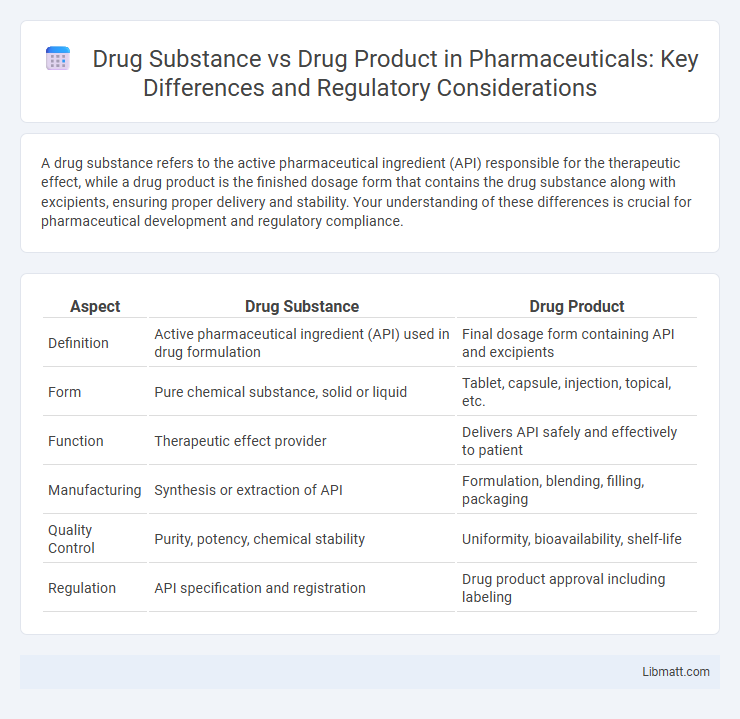A drug substance refers to the active pharmaceutical ingredient (API) responsible for the therapeutic effect, while a drug product is the finished dosage form that contains the drug substance along with excipients, ensuring proper delivery and stability. Your understanding of these differences is crucial for pharmaceutical development and regulatory compliance.
Table of Comparison
| Aspect | Drug Substance | Drug Product |
|---|---|---|
| Definition | Active pharmaceutical ingredient (API) used in drug formulation | Final dosage form containing API and excipients |
| Form | Pure chemical substance, solid or liquid | Tablet, capsule, injection, topical, etc. |
| Function | Therapeutic effect provider | Delivers API safely and effectively to patient |
| Manufacturing | Synthesis or extraction of API | Formulation, blending, filling, packaging |
| Quality Control | Purity, potency, chemical stability | Uniformity, bioavailability, shelf-life |
| Regulation | API specification and registration | Drug product approval including labeling |
Introduction to Drug Substance and Drug Product
Drug substance refers to the active pharmaceutical ingredient (API) responsible for the therapeutic effect in a medication, characterized by its chemical structure, purity, and potency. Drug product encompasses the finished dosage form, including the drug substance combined with excipients, designed for safe and effective delivery to patients. Understanding the distinction between drug substance and drug product is critical for regulatory compliance, manufacturing, and quality control in pharmaceutical development.
Definitions: Drug Substance vs Drug Product
Drug substance refers to the active pharmaceutical ingredient (API) responsible for the therapeutic effect in a medication, characterized by its chemical or biological composition and purity standards. Drug product encompasses the final formulated dosage form containing the drug substance along with excipients, designed for administration to patients. Understanding the distinction between drug substance and drug product is crucial for regulatory compliance, manufacturing processes, and quality control in pharmaceutical development.
Key Differences Between Drug Substance and Drug Product
Drug substance refers to the active pharmaceutical ingredient (API) responsible for the therapeutic effect, while the drug product is the final formulated medication containing the drug substance along with excipients and packaging. Key differences include the drug substance's chemical purity and pharmacological activity, contrasted with the drug product's dosage form, stability, and delivery mechanism. Understanding these distinctions is crucial for ensuring Your medication's safety, efficacy, and quality throughout development and use.
Regulatory Perspectives on Drug Substance and Drug Product
Regulatory agencies such as the FDA and EMA require distinct documentation for drug substances and drug products, focusing on quality, purity, and manufacturing controls for drug substances, and efficacy, safety, and consistent dosage for drug products. Drug substance guidelines emphasize synthetic routes, impurities, stability, and characterization, while drug product regulations address formulation, bioavailability, packaging, and labeling. Compliance with ICH guidelines Q7 for drug substances and Q8-Q11 for drug products ensures harmonized standards across global markets.
Manufacturing Processes: Drug Substance vs Drug Product
The manufacturing process of a drug substance involves the synthesis, purification, and isolation of the active pharmaceutical ingredient (API) at a molecular level, emphasizing chemical reactions and quality control of raw materials. Drug product manufacturing focuses on formulating the drug substance into a final dosage form, such as tablets or injectables, incorporating excipients, ensuring proper dosage, stability, and packaging. Your understanding of these processes is crucial for maintaining compliance with regulatory standards and ensuring drug efficacy and safety.
Quality Control in Drug Substance and Drug Product
Quality control in drug substance involves rigorous testing of raw materials and active pharmaceutical ingredients (APIs) to ensure purity, potency, and absence of contaminants, establishing a foundation for safe drug development. Quality control in drug product extends to final formulation testing, including assays for stability, dosage accuracy, and packaging integrity to guarantee the medication's safety and efficacy for patient use. Your understanding of these distinct but complementary QC processes ensures compliance with regulatory standards and delivers reliable therapeutic outcomes.
Stability Considerations for Drug Substance and Drug Product
Stability considerations for drug substance involve assessing the chemical, physical, microbiological, and biological properties to ensure the active pharmaceutical ingredient (API) maintains its identity, strength, purity, and quality over time. Drug product stability focuses on the formulation, including excipients and packaging, to guarantee the finished dosage form remains safe, effective, and meets specifications throughout its shelf life. Environmental factors such as temperature, humidity, and light exposure critically impact both drug substance and drug product stability, necessitating rigorous stability testing protocols.
Documentation and Compliance Requirements
Drug substance documentation includes detailed chemical, physical, and biological property data, along with manufacturing processes and control strategies, ensuring compliance with regulatory standards such as ICH Q7. Drug product documentation focuses on formulation development, stability data, packaging, labeling, and finished product specifications to meet regulatory guidelines like FDA's 21 CFR Part 211. Both require comprehensive validation reports, batch records, and quality control data to support product safety, efficacy, and traceability across the supply chain.
Role in Pharmaceutical Development and Approval
The drug substance, also known as the active pharmaceutical ingredient (API), is the chemically active component responsible for the therapeutic effect and undergoes rigorous characterization during pharmaceutical development. The drug product includes the drug substance combined with excipients to form the final dosage form, requiring comprehensive evaluation of formulation, stability, and bioavailability for regulatory approval. Regulatory agencies such as the FDA and EMA mandate detailed documentation of both drug substance and drug product manufacturing processes to ensure quality, safety, and efficacy throughout the drug approval process.
Conclusion: Importance of Distinguishing Drug Substance and Drug Product
Distinguishing between drug substance and drug product is critical for regulatory compliance, quality control, and patient safety. Drug substance refers to the active pharmaceutical ingredient (API) responsible for therapeutic effect, while drug product signifies the finished dosage form containing the API and excipients. Clear differentiation ensures proper manufacturing processes, stability testing, and labeling, minimizing risks and optimizing clinical outcomes.
Drug substance vs drug product Infographic

 libmatt.com
libmatt.com